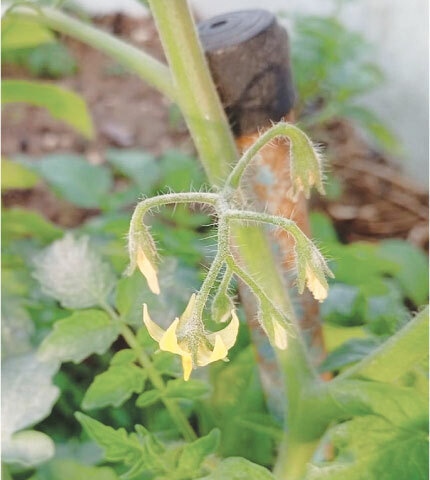
With various aspects of sowing the seed, sustaining the seedling and growing a determinate tomato plant discussed in earlier columns, we will now focus on the phase where the plant begins to approach maturity. During this phase, the focus usually shifts to the fruit-bearing capacity and production efficiency of the plant. But just before that, there is another critical aspect to the fruiting phase — the flowering phase.
As with other things on Earth, the presence of male and female is essential to maintain the continuity of generations and production of offsprings. Seemingly, the phenomenon is more or less the same in plants as well. Broadly, it can be categorised as any of the either — male and female flowers on different plants, male and female flowers on the same plant or, in the case of tomato plants, male and female parts of the same flower — all contributing to the sustenance of life and production of fruits.
Apart from self-pollinating flowers, and those which require air or water medium for transporting pollen, most flowers require some sort of external support. In such cases, for pollination and fertilisation to ensue, the role of pollinators becomes critical. The reproductive material, pollens, which is essential for pollination, is carried through different vectors or pollinators, which include insects, flies, birds and even small animals.
Tomato plants are self-pollinating, but in the absence of natural pollinators or a helping hand, its flowers may go to waste…
The flower of the tomato plant falls in the third category of pollinating flowers mentioned above. Tomato belongs to the family Solanaceae, which are also called nightshade. While it is not empirically proven, some people believe that they are called “nightshade” because they usually flower at night.
This phenomenon results in one major hindrance to pollination for any kitchen gardener. At night, there are hardly any pollinators available — especially in metropolises. There is a high probability of flowers going to waste, if there is no timely intervention.
The buds and, subsequently, the flowers of the tomato plant appear in a cluster. Depending on the variety and growing conditions, buds usually appear on the plant during the second month after germination. Soon enough, light-weight yellow-coloured flowers, which usually have five to six petals, start to blossom. The flowers of the tomato plant have both stamen (male part) and pistil (female part) on the same flower. It means that the tomato flower has both the reproductive organs in the same flower. While tomato flowers can self-pollinate with minimal intervention, the availability of external support (wind, vibrations or hand-pollination) increases success.

Gardeners can assist with hand-pollination by gently tapping the base of the flower or lightly shaking the plant, helping to dislodge and transfer pollen within the flower. It usually results in the pollination of the flower. New gardeners worried about damaging the flower can lightly shake the branch and it is likely to also fulfil the purpose.
There are a few factors that may hinder the probability of pollination from occurring. Sometimes, flowers may wither, with the flower-stalks turning yellowish-brown in colour. Sudden temperature variations, increased humidity, an irregular watering schedule, excess nitrogen content of the soil and many other uncommon factors may cause the flowers to fall off.
It is of utmost importance to keep these factors in check. In the case of increased temperatures, misting of the plant and installation of a green net overhead is advised. Once the buds start to appear on the tomato plant, the nitrogen-based fertilisers should be immediately replaced with potassium-based fertilisers.
While growing tomato plants, there are two schools of thought. One focuses on the main, central stem and prunes off the side branches. The other group, however, nurtures the branches and makes the plant bushy. They believe that more branches will result in increased flowering and fruiting.

In both the cases, the side branches or shoots that tend to grow quickly from the axil — the place where a leafy branch meets the vertical stem — are to be removed. These branches, also known as suckers, grow at 45 degrees from the stem and sap the plant of its energy. Removing these branches helps the plant to focus more on the flowering and fruiting phases ahead.
Please send your queries and emails to doctree101@hotmail.com. The writer is a physician and a host for the YouTube channel ‘DocTree Gardening’ promoting organic kitchen gardening
Published in Dawn, EOS, March 2nd, 2025













































